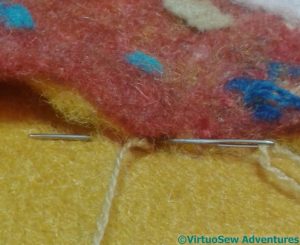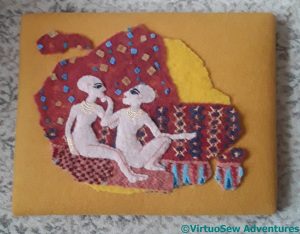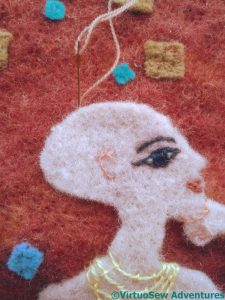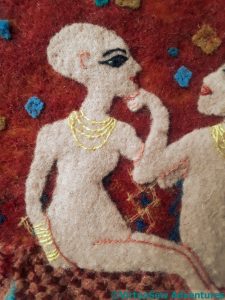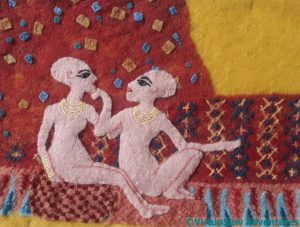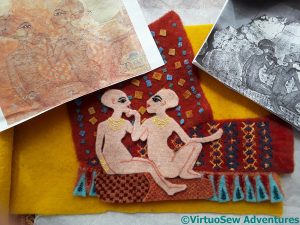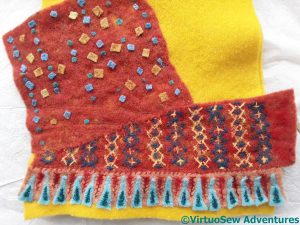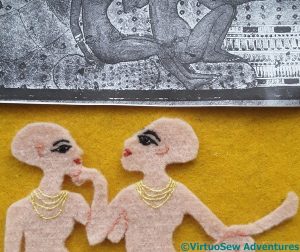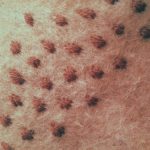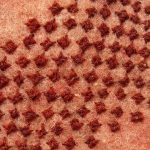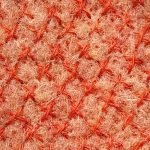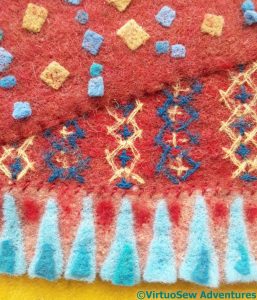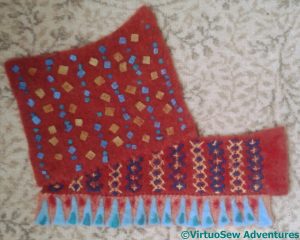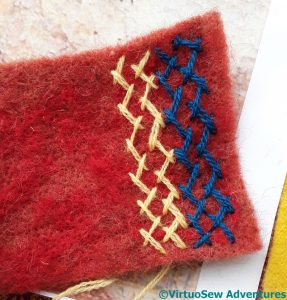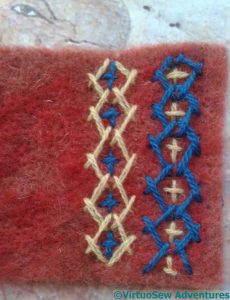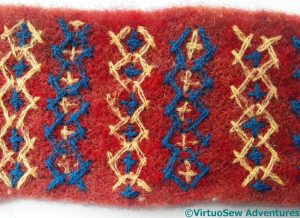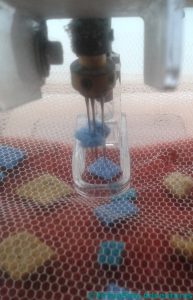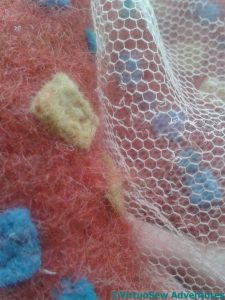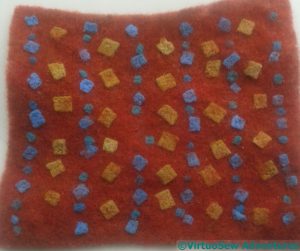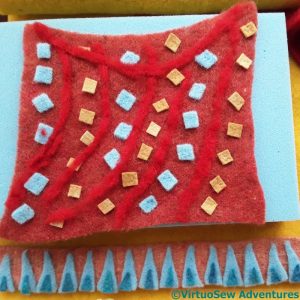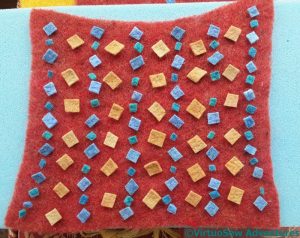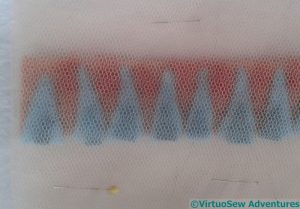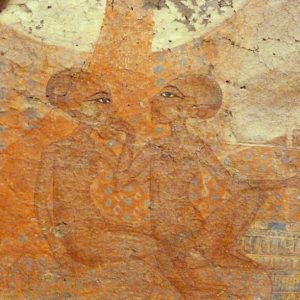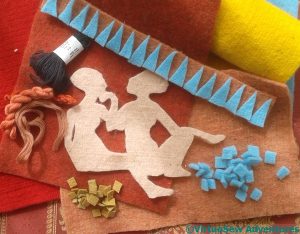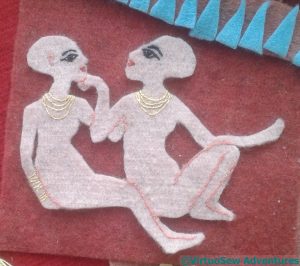Tag: Two Amarna Princesses
Mounting the Two Amarna Princesses
I felt that the finishing technique for the Amarna Geese really worked, creating just the right impression of a fragment of fresco, so, after thinking it over a little more, I tackled the Princesses.
The depth of layering of the felts made it much easier to attach to the padded mount, although if I could only have found my curved needles, it might have been yet easier.
Again, I couldn’t bring myself to chop the princesses into bits. If I had thought of the display method to begin with, and created the piece with that in mind, I might have been able to do so, but as it is – they are so exquisite, I simply couldn’t do it!
Finally mounted, with the separate bits on the corners. They look just the way I hoped they would!
Two Amarna Princesses – Finishing Details
I decided that I would actually sew down the princesses. Everything else has been needlefelted into place, but the texture that creates, especially on a light felt, is a bit too regimented for the impression I want to convey.
I’ve very carefully, and as near as I can make it, invisibly, attached the felt around the edges, stitching into the thickness of the felt that makes the two girls and using a wool thread that is close in colour to the felt.
So far, so good.
I then used a hand needlefelting tool and went just around the edges, and into the sections that are further back. I’m trying to create a slightly sculptural effect, so that the princesses have a slight roundness to them. Remember how, at the beginning, I said I wanted to recall the scene as the original fresco artist may have seen it, as well as recalling the fresco itself?
I’m rather pleased with my two little princesses.
I need to work a little magic in straightening up the panel and working out how to display it, as I think the three felt panels that I’ve done so far would all die if put behind glass, and may not even be happy in frames. A question for another day.
Two Amarna Princesses – the results of thought
The felted cushion fragments worked rather well, surviving the cutting out procedure so that I could start to play with the layout. Prints of the images I’d used to hand, I fiddled happily for quite a while.
This isn’t quite what I ended up with, but you can see how vividly the colours play off against one another. Very promising!
The first stage was to attach the drapery assembly to the background. This is where the experimental nature of my needlefelting may come back to bite me, because there is a risk that I have taken it too far, and that I will finish with a completely destroyed background.
However, the goldeny-mustardy-yellow wall shows through a bit, which is what I want, as that helps to make the connection with the frescoes at Amarna as they are found by archaeologists – fragile and fragmentary, only a hint of their former glory. I may have to hand-needlefelt some of those little squares, as they’re not as well attached as I would like. I don’t want them falling off at some time in the future!
Two Amarna Princesses – having to think again
A little while ago, the Ashmolean Museum tweeted another reproduction of that fresco of the two little princesses, this one in black and white, and it brought to the fore something that had been less clear in the colour reproductions I had seen – the girls are actually sitting on cushions. Originally, I had interpreted the lowest border design as fabric covering a divan of some sort, but now I found myself developing some possible cushion fabrics..
- Satin Stitch Spots
- Sorbello Stitch Spots
- Cross Stitch Spots
Once again, as with the drapery, I stitched patterns with additional needlefelting in mind. I decided in the end that the satin stitch spots weren’t working very well. Sorbello stitch is the stitch I used for the villages on the Map of Amarna. It’s another stitch I rather like, as it produces a neat, square stitch, with an interesting texture – more obvious with some fabrics and threads than others, of course. The cross stitch spots are in a colour closer to that of the felt, and should produce a more subtle effect.
What I have done is to stitch the patterns on a section of felt, and then pass it under my embellisher. I hope that this will create enough fibre entanglement that when I cut out the cushion shapes, the stitches will not unstitch themselves.
I wonder whether it will work…!
Two Amarna Princesses – Assembling the Drapery
Having chosen my bits of drapery, I’ve stitched them together at the edges.
This means that they won’t move when I’m felting them to the background, and that I could actually cut off some of the second drapery, rather than overlapping it on the first. This will reduce the number of layers I will be felting through, which turns out to be a good idea. I don’t want any more broken needles, thank you very much!
The assembled drapery now makes a rather peculiar shape, but it gives me part of the background for my princesses, and a basis for any further embellishment I may feel is necessary.
However, as I was contemplating that eventual embellishment, I found another source picture and now I have to do a little more thinking.
The Two Amarna Princesses – Drapery, stage 3
For my next drapery experiment, I began by using the embellisher to add some of that divided felt onto another piece – do you see that the red is in patches, a dark pink (the background) and a rather brighter scarlet? That worked well, I think, as it has warmed up the colour, and made it more interesting.
I had decided that I would stitch a pattern and then use the embellisher to make it blend in a little more, but once I’d worked this pattern of herringbone stitch stripes, I sat back, stared at it, and said “No”.
So the second pattern I tried was a little more complex. It’s still worked largely in herringbone stitch, and the colours are the same, but this time I’ve reversed the second row to create a series of lozenge shapes, which could then be filled in, after a fashion, with little upright cross stitches.
I liked this much more, so I decided to go with this pattern.
Although, of course, I was referring to the picture that was my original spacing, that red is very reminiscent of Persian carpets, and the combination with blue and yellow is one which we still find in widespread use.
The next stage was to use the embellisher again. To begin with, I covered the stitching with a layer of net, and worked an initial pass of small circling movements, up and down each stripe. Then I removed the net and kept going.
As you can see, the stitching is almost melting into the background. Certainly it’s a more convincing representation of a piece of fabric than my first piece of drapery, although I will be using both.
The Two Princesses – Drapery, stage 2
The idea of using the netting is that it does not become caught up in the embellished fabric, and that it prevents bits of embellishment from becoming caught up on the needlehead and generally misbehaving.
As you can see, that sometimes doesn’t work quite as well as one might wish! Fragments can, and do, work themselves through the holes torn in the netting by the embellisher’s needles, and then jump with alacrity onto the needles, where they whizz up and down before the bemused eyes of the person operating the machine, causing no little apprehension as they do it!
There’s something else that doesn’t quite go to plan, as well. The netting does indeed become somewhat enmeshed with the felt.
As you can see, my little additions are by no means felted into the backing piece, but I’m already having to be very careful to peel off the netting, and if I had done much more with the embellisher, I might never have got the netting off at all!
I think it would be fair to say that I don’t really have anything like a real understanding of the effect of the embellisher on particular materials or combinations of materials. I’ve several more projects in mind so I’m sure my understanding will grow, but even by my standards, this is a venture into the unknown.
You can see that some of the pieces moved, and some never attached themselves at all. The pattern is distinctly higgledy-piggledy, and the elements aren’t equally firmly attached.
That said, I’ve managed to create something that has the warm red and the flashes of blue and gold, and although it isn’t the same pattern as the one in the fresco, it is certainly reminiscent of it.
I’m going to try another method entirely for a second section of drapery, and see whether that creates the effect I want.
Starting the drapery for the Two Princesses
I’m going to build up the panel in layers, so I began by playing with bits of felt. I’ve cut small squares and triangles from other pieces of felt I have to hand, and begun to make some attempts to build up patterns with them.
The darker red shown here is actually one of the pre-felts painstaking split horizontally and then cut into bits. The idea was to produce something that gave the impression of folds in the drapery. I’ve come to the conclusion that that doesn’t work, and what’s more, I don’t think it ever will, partly because needlefelt applique turns out not to be a terribly exact science..
This seemed better. You’ll notice that it’s a bit haphazard, and that it runs over the whole piece, even though we know I will be covering quite a bit of it with the princesses themselves. I learnt a long time ago (with the Camberwell Panel, in fact) that when layering like this it is a false economy of time and effort to attempt to minimise the details on intermediate layers. This way I have more freedom for the exact placement, and can move the pieces around until I am happy with them.
Once I had layouts I was happy with, for both the drapery at the back and the patterned bench or divan covering the girls are sitting on, I created sandwiches of netting with my layouts- lightly hand-needlefelted – in the middle, and two layers of net back and front.
Time to get my embellisher out of its box!
Two princesses
There’s a fresco of two of the daughters of Akhenaten and Nefertiti, which is quite well known, and indeed, was mentioned to me by the speaker, when I went to a lecture at the Egypt Exploration Society about the textiles in Tutankhamun’s tomb. I decided to have a go at representing this fragment using my embelllisher, to provide a companion piece for the three Amarna Geese I worked a while back.
Children in ancient Egypt – of whatever rank – appear to have run around naked much of the time, and with shaven heads. I’ll just have to get the outlines right….
I bought some more of the pre-felts I used for the Amarna Geese at “Sewing For Pleasure” in Birmingham, on the day I met up with Sue of Tortoiseloft blog.
Then I printed out the image I found online as large as I could and started planning my variation. It won’t, of course, be an exact reproduction of the fresco. It will be a sort of inlaid felt version of what I think might have been the real life inspiration for the scene.
Long-time readers may recall that I discovered with the Amarna Geese that embroidered details help to bring a scene to life, and at least if the embroidery is worked in wool, responds well to being needlefelted.
So after cutting out my two little princesses, in a single piece, I started to add details – lines to make sense of the bodies, the delicate eyes and eyebrows, the lips, and the necklaces. I’m very pleased with how they’ve turned out, because the felt doesn’t take pencil, so I was on my own – drawing with my needle.
Now I have to work out how to create the impression of the fabric backdrop and bench my two little princesses are sitting on….

